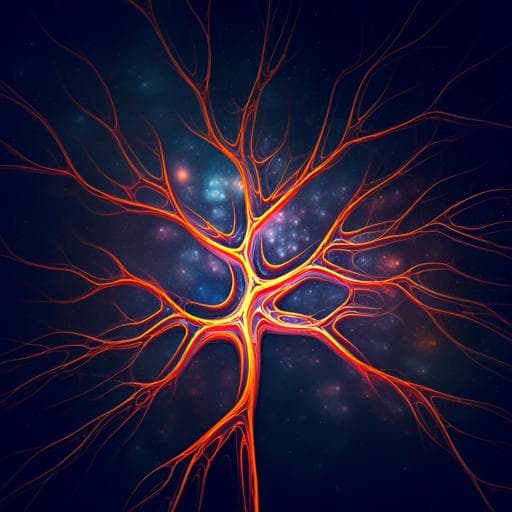
Medicine and Health
Physics-informed deep generative learning for quantitative assessment of the retina
E. E. Brown, A. A. Guy, et al.
Discover a groundbreaking algorithmic approach that revolutionizes the generation of realistic digital models of human retinal blood vessels. This innovative method, developed by Emmeline E. Brown and colleagues, surpasses traditional labeling performance through physics-informed generative adversarial networks, paving the way for enhanced early detection and monitoring of retinal diseases.
~3 min • Beginner • English
Introduction
Retinal vascular disruption is implicated in common blinding diseases such as diabetic retinopathy and macular degeneration and is also a window into systemic conditions including vascular dementia and cardiovascular disease. Automated, scalable quantification of retinal vasculature from clinical imaging is therefore clinically valuable, but current supervised deep learning approaches are limited by the scarcity, cost, and variability of high-quality manual annotations, particularly for small and capillary-level vessels and artery–vein differentiation. The study asks whether biophysically informed simulations of fully connected arterial–venous retinal networks, combined with cycle-consistent generative adversarial learning, can (1) generate realistic multimodal retinal images and (2) enable accurate, annotation-free segmentation and reconstruction of vasculature from clinical images, while also supporting flow and contrast delivery inference.
Literature Review
Prior work in retinal image analysis has focused on supervised deep learning, notably U-net and its variants, for tasks like OCT layer and vessel segmentation, but performance is constrained by limited labeled data and inter-/intra-grader variability. GAN-based methods have been used for retinal fundus and OCT-A segmentation and style translation, and synthetic data strategies have been explored in other vascular imaging contexts. Space colonization algorithms have generated macular vessel patterns for learning tasks. Despite these advances, most segmentation remains 2D, often under-segments faint or small vessels, and rarely distinguishes arteries from veins. There is a need for methods that leverage physiological principles, work across wide-field, high-resolution modalities, and reduce dependence on manual labels.
Methodology
The approach combines procedural, biophysics-informed simulation of retinal vascular networks with cycle-consistent GANs for bidirectional translation between simulation and clinical image domains.
- Procedural network generation: A 26-parameter model seeded arterial and venous trunks using an L-system positioned at the optic disc, followed by multiscale growth via constrained constructive optimisation (CCO) and lattice sequence vascularisation to produce space-filling, planar networks consistent with Murray’s law (exponent ~2.4±0.11). Initial artery/vein radii were 135±15 µm and 151±15 µm. A macula-specific growth stage enforced radial arteriolar/venular architecture, increased local flow density (1.5–2.0×), and preserved a central avascular fovea. Vessel tortuosity was imposed by superimposing sinusoidal displacements with amplitude proportional to radius (larger for veins), and low/high-frequency periods scaled to vessel size, with phase continuity through bifurcations. Arterial and venous trees were connected via a continuous capillary bed generated with either 2D Voronoi-based connectivity or a space colonization algorithm. Final networks were projected onto a hemispherical mesh (23–25 mm diameter) incorporating macula and optic disc topography.
- Flow and fluorescein simulation: Blood flow was modeled with a connectivity-based 1D Poiseuille framework (REANIMATE) exploiting the single arterial inlet and venous outlet to impose pressure boundary conditions sampled from literature distributions (artery 56.2±14.0 mmHg; vein 20.0±10.0 mmHg). Systemic fluorescein kinetics were represented as the sum of two displaced Gaussians (first and second passes) plus an exponential washout; vessel-wise time courses were advected along the network according to local velocities and flow partitioning at bifurcations.
- Pathology simulation: Retinal vein occlusion (RVO) was modeled by reducing diameter by 80% at a randomly selected A–V crossover on a large vein, recomputing flow to quantify hypoperfusion. Diabetic retinopathy (DR) was approximated by stochastically occluding arterioles with radius <35 µm in batches, progressing from peripheral to more central regions, removing non-perfused vessels to yield ischemic zones.
- Image domain translation with PI-GAN: Three CycleGANs were trained to map between synthetic vascular renderings and modalities: retinal photographs, OCT-A en face, and fluorescein angiography (FA). Synthetic retinas were voxelized to match OCT-A resolution (axial 6.3 µm, lateral 21 µm). Training sets comprised 590 retinal photographs, 43 OCT-A en face images, 570 FA images, plus 130 simulated networks. Unpaired, bidirectional mappings were trained using standard adversarial, cycle-consistency, and identity losses (ADAM optimizer, β1=0.5, β2=0.999; 500 epochs; LR 2e-4 decaying to 2e-5; crop 256 px; batch size 1). Frechet Inception Distance (FID) quantified realism of generated images.
- Segmentation via reverse mapping: The reverse CycleGAN mapping transformed clinical images (OCT-A, fundus, FA) into the simulation domain to yield vessel segmentations and connectivity. For OCT-A, training emphasized detection of smaller “elusive” vessels; for fundus datasets, the synthetic set was filtered so minimum vessel diameter matched photographic resolution (~100 µm) to ensure fair benchmarking against manual labels.
- Validation datasets and manual labeling: 19 OCT-A datasets (healthy volunteers) were manually segmented with custom 3D tracing tools; artery/vein labels were assigned in a subset (n=5) using retinal photographs. Metrics computed included branching angle, inter-branch length, tortuosity, diameter, and network volume across macula (5.5 mm circle), optic disc (3.6 mm circle), and periphery. ANOVA tested differences between simulated and real distributions, adjusting for eye (OD/OS), sex, and scan pattern.
- Evaluation metrics: FID for realism and Dice score for segmentation similarity to manual labels. Expert review assessed presence of additional small vessels segmented by PI-GAN in DRIVE/STARE.
Key Findings
- Geometric realism of simulations: Across 100 synthetic networks vs 19 manually segmented OCT-A images, ANOVA found no significant differences for branching angle (p=0.824), vessel length (p=0.177), tortuosity (p=0.095), network volume (p=0.061), or diameter (p=0.593) across macula, optic disc, and periphery.
- Flow validation: With arterial and venous pressures set to 56.2±14.0 and 20.0±10.0 mmHg, the predicted total retinal flow was 34.4±1.8 µL/min, slightly lower but consistent with literature values (e.g., 45.6±3.8, 44±13, and 50.7 µL/min). Simulated fluorescein angiography yielded an arterial-to-venous filling delay of 7.3±0.7 s (n=1000 runs), matching clinical timings; qualitative arterial, venous, and recirculation phases resembled clinical FA.
- Pathology simulation: RVO modeled by an 80% local venous diameter reduction produced a large downstream hypoperfused territory and a regional flow reduction of 9.8 µL/min, consistent with clinical FA. DR simulations (random occlusion of arterioles <35 µm progressing centrally) produced ischemic regions with preserved traversing vessels, visually concordant with OCT-A from advanced DR.
- Image synthesis realism: FID scores indicated close similarity between synthetic and real images—retinal photographs 6.95, FA 5.17, OCT-A 3.06—with baseline FIDs from real-vs-real domain pairs provided for reference.
- Segmentation without manual labels: On OCT-A, PI-GAN detected substantially more small vessels than manual labels; consequently, average Dice vs manual was low (0.35±0.12) but sensitivity was high (87.1%±1.20%), indicating it captured nearly all manually identified vessels while adding plausible small vessels.
- Public dataset benchmarking (fundus): Without manual training labels, PI-GAN achieved Dice 0.75 (0.11) on DRIVE and 0.82 (0.091) on STARE, comparable to state-of-the-art supervised methods (STARE 0.8378; DRIVE 0.8275) despite limited synthetic training data and domain differences (wider FOV in study images). Expert review judged that PI-GAN often identified additional small vessels possibly present (90% of DRIVE, 80.95% of STARE), though image quality limited certainty.
Discussion
The study demonstrates that biophysical simulations of fully connected arterial–venous retinal networks can be aligned with clinical image domains through cycle-consistent GANs to produce realistic multimodal images and enable annotation-free vessel segmentation. Close agreement of simulated and real geometric metrics across retinal regions supports the simulations’ fidelity, which in turn sustains robust bidirectional image translation. Flow and fluorescein simulations corroborate physiologic plausibility (total flow and AV filling delay), enabling interpretation of temporal dynamics and disease patterns. When applied to clinical OCT-A and fundus photographs, PI-GAN achieves high sensitivity to vessels annotated by humans and identifies additional small vessels that are likely physiologic but often missed in manual segmentations, challenging the adequacy of manual labels as a gold standard. Benchmark performance on public datasets approaches or matches state of the art achieved by supervised methods, despite requiring no human annotations. The framework further supports mechanistic inference, including modeling of RVO- and DR-like perfusion deficits, and offers potential extensions to oxygen delivery, AV-specific segmentation, and interpretable AI linking structure, flow, and disease.
Conclusion
This work introduces a physics-informed, generative framework that unifies biophysical retinal vascular simulation with cycle-consistent deep generative learning to: (1) generate realistic multimodal retinal images with paired ground-truth vasculature, (2) segment vasculature from clinical images without manual labels while maintaining high sensitivity and detecting small vessels, and (3) simulate physiologically plausible flow, contrast delivery, and disease patterns. The approach is promising for scalable, quantitative assessment of retinal health and for investigating systemic disease signatures in the retina. Future directions include artery–vein classification and connectivity enforcement, modeling oxygen delivery and hemodynamics under varied conditions (aging, hypertension), incorporating choroidal supply for whole-ocular perfusion modeling, exploring regional flow variability, integrating therapeutic simulations (e.g., anti-VEGF effects), augmenting supervised training with inherently paired synthetic data, and advancing interpretable AI grounded in biophysical laws.
Limitations
- Manual segmentation as a reference standard is imperfect, particularly for small and faint vessels; this contributes to lower Dice despite high sensitivity and may underestimate true performance. A small proportion (0.67%) of PI-GAN false positives (“hallucinations”) were noted.
- Public fundus datasets (DRIVE/STARE) have limited image quality and narrower FOV than the wide-field images used elsewhere in the study, complicating definitive assessment of small-vessel detection and generalization.
- OCT-A training data size was modest (43 en-face images), and vascular labeling (including artery–vein status and full connectivity) was limited to a subset, potentially constraining evaluation breadth.
- Flow simulations rely on literature-based boundary conditions and a 1D Poiseuille model; capillary-level and choroidal contributions are simplified or excluded.
- Disease models (RVO, DR) are stylized (e.g., stochastic occlusions, fixed stenosis) and do not capture full clinical heterogeneity.
Related Publications
Explore these studies to deepen your understanding of the subject.







